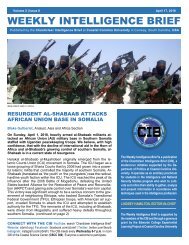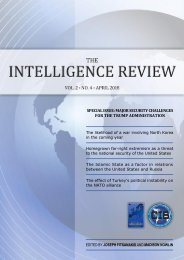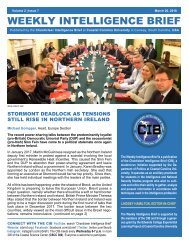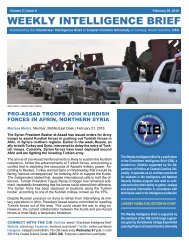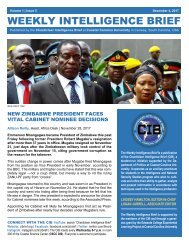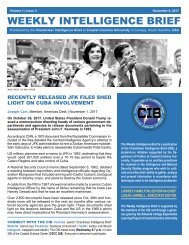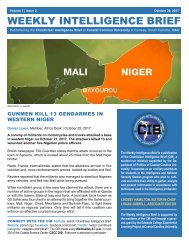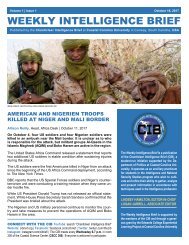The Intelligence Review | volume 3 | issue 5 |
This volume is the product of a collaboration between the European Intelligence Academy (EIA) and the Chanticleer Intelligence Brief (CIB), a pre-professional body supported by the Department of Politics at Coastal Carolina University in Conway, South Carolina, United States. Six CIB analysts tackle some of the most pressing and timely questions confronting intelligence observers today. Topics in this issue include the current and projected strength of the al-Shabaab militant group in East Africa, the future of the Iran nuclear agreement, and the current state of Mexico’s drug cartels. The issue also contains an analysis of the rising tension between the European Union and the government of Poland, as well as of the complex relationship between the United States and Cuba. The compendium concludes with an eye-opening report on the state of Middle Eastern linguistics in the United States Intelligence Community in the post-9/11 era.
This volume is the product of a collaboration between the European Intelligence Academy (EIA) and the Chanticleer Intelligence Brief (CIB), a pre-professional body supported by the Department of Politics at Coastal Carolina University in Conway, South Carolina, United States. Six CIB analysts tackle some of the most pressing and timely questions confronting intelligence observers today. Topics in this issue include the current and projected strength of the al-Shabaab militant group in East Africa, the future of the Iran nuclear agreement, and the current state of Mexico’s drug cartels. The issue also contains an analysis of the rising tension between the European Union and the government of Poland, as well as of the complex relationship between the United States and Cuba. The compendium concludes with an eye-opening report on the state of Middle Eastern linguistics in the United States Intelligence Community in the post-9/11 era.
Create successful ePaper yourself
Turn your PDF publications into a flip-book with our unique Google optimized e-Paper software.
Background<br />
Mexican cartels were forever altered by the criminal rise of Escobar.<br />
Throughout the 1970s, as he networked with other criminals to form<br />
the Medellín Cartel of Colombia, Escobar acquired control of the<br />
production of nearly 80 percent of the cocaine disseminated into the<br />
United States (US). His approach to leadership, infrastructural tactics,<br />
drug trafficking, and territorial domination appealed immensely to<br />
Gallardo. <strong>The</strong> success of Gallardo, the chief of Mexico’s Guadalajara<br />
Cartel, mirrored the successes of Escobar and his Medellín Cartel, so<br />
the two were in close cooperation as producers (Medellín Cartel) and<br />
distributors (Guadalajara Cartel) of cocaine (Becerra and Parra 2012:1).<br />
By the 1980s, the Guadalajara Cartel had control of nearly all drug<br />
trafficking in Mexico and across the border into the US. While still very<br />
much operating under the shadow of the overall efficiency and productivity<br />
of the Colombian cartels, Gallardo modeled the Guadalajara Cartel as a<br />
template for the future growth of all other Mexican cartels (Longmire<br />
2016). In 1985, Gallardo was incarcerated for the murder of the Drug<br />
Enforcement Administration (DEA) agent Enrique Camarena, and<br />
was thus effectively taken off the streets. But his legacy is imprinted<br />
upon Mexico’s modern-day cartels, which have since evolved from the<br />
now defunct Guadalajara Cartel. Today, key players in Mexico’s drug<br />
war are the Sinaloa Cartel, the CJNG, the Gulf Cartel, and both factions<br />
of the Los Zetas Cartel (US Drug Enforcement Administration 2017).<br />
Once working as Gallardo’s logistics supervisor, Joaquín ‘El Chapo’<br />
Guzmán became a recognized leader of the Sinaloa following the<br />
dismantlement of the Guadalajara Cartel. Throughout the 1990s and<br />
early 2000s, El Chapo gained exclusive power over the Sinaloa and its<br />
operations. But thirst for power caused fragmentation within the cartel<br />
(Beittel 2017:13). In 2010, the paramilitary wing of the Sinaloa, referred<br />
to as the Milenio Cartel, splintered when Sinaloa leaders refused to<br />
promote Rubén ‘El Mencho’ Cervantes as the leader of the wing.<br />
Following the split, El Mencho and trained operatives of the Milenio<br />
Cartel formed the CJNG (Beittel 2017:22).<br />
<strong>The</strong> Rise of the CJNG<br />
<strong>The</strong> CJNG strategically centered its foundation on the geographical<br />
habitat of its membership in Guadalajara, the largest city and capital of<br />
the Mexican state of Jalisco. <strong>The</strong> new cartel had several opportunities<br />
36








